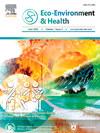Targeted conversion of waste PET into dimethyl terephthalate and ethylene carbonate under metal-free conditions
引用次数: 0
Abstract
Ionic liquid-catalyzed methanolysis emerges as an efficient technique for transforming PET into premium-grade dimethyl terephthalate (DMT). However, incomplete depolymerization remains a major obstacle to the further industrial application of IL-catalyzed PET methanolysis. The proposed method utilized dimethyl carbonate (DMC) as the solvent for the complete methanolysis of waste PET under mild conditions, resulting in pure DMT and ethylene carbonate (EC) within 2.5 h. The use of 1-ethyl-3-methylimidazolium acetate ([EMIm][OAc]) as the IL catalyst significantly enhanced the reaction efficiency. Spectroscopic analyses using 1H NMR and FT-IR confirmed the pivotal role of [EMIm][OAc] in establishing multiple hydrogen bonds with the reactants (PET, DMC, and MeOH) and the intermediate [ethylene glycol (EG)] during the catalytic process. This catalytic system exhibited remarkable performance, achieving complete conversion of PET, which resulted in the production of DMT and EC with yields of 99% and 91%, respectively. Moreover, this versatile approach is applicable to the upcycling of a wide variety of commercial polyesters and polycarbonates, underscoring its potential as a comprehensive solution for plastic waste management.

废PET在无金属条件下定向转化为对苯二甲酸二甲酯和碳酸乙烯
离子液体催化甲醇分解是将PET转化为优质对苯二甲酸二甲酯(DMT)的一种有效技术。然而,不完全解聚仍然是阻碍il催化PET甲醇分解进一步工业应用的主要障碍。该方法以碳酸二甲酯(DMC)为溶剂,在温和条件下对废PET进行完全甲醇分解,在2.5 h内得到纯DMT和碳酸乙烯酯(EC)。采用1-乙基-3-甲基咪唑醋酸酯([EMIm][OAc])作为IL催化剂,显著提高了反应效率。利用1H NMR和FT-IR进行的光谱分析证实了[EMIm][OAc]在催化过程中与反应物(PET, DMC和MeOH)和中间体[乙二醇(EG)]建立多个氢键的关键作用。该催化体系表现出优异的性能,实现了PET的完全转化,得到了DMT和EC,产率分别为99%和91%。此外,这种通用方法适用于各种商业聚酯和聚碳酸酯的升级回收,强调了其作为塑料废物管理综合解决方案的潜力。
本文章由计算机程序翻译,如有差异,请以英文原文为准。
求助全文
约1分钟内获得全文
求助全文
来源期刊

Eco-Environment & Health
环境科学与生态学-生态、环境与健康
CiteScore
11.00
自引率
0.00%
发文量
18
审稿时长
22 days
期刊介绍:
Eco-Environment & Health (EEH) is an international and multidisciplinary peer-reviewed journal designed for publications on the frontiers of the ecology, environment and health as well as their related disciplines. EEH focuses on the concept of “One Health” to promote green and sustainable development, dealing with the interactions among ecology, environment and health, and the underlying mechanisms and interventions. Our mission is to be one of the most important flagship journals in the field of environmental health.
Scopes
EEH covers a variety of research areas, including but not limited to ecology and biodiversity conservation, environmental behaviors and bioprocesses of emerging contaminants, human exposure and health effects, and evaluation, management and regulation of environmental risks. The key topics of EEH include:
1) Ecology and Biodiversity Conservation
Biodiversity
Ecological restoration
Ecological safety
Protected area
2) Environmental and Biological Fate of Emerging Contaminants
Environmental behaviors
Environmental processes
Environmental microbiology
3) Human Exposure and Health Effects
Environmental toxicology
Environmental epidemiology
Environmental health risk
Food safety
4) Evaluation, Management and Regulation of Environmental Risks
Chemical safety
Environmental policy
Health policy
Health economics
Environmental remediation
 求助内容:
求助内容: 应助结果提醒方式:
应助结果提醒方式:


